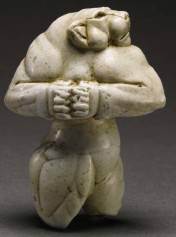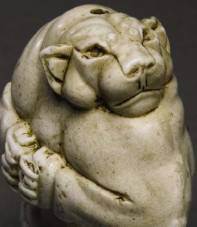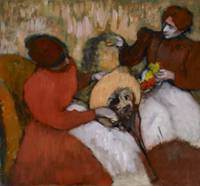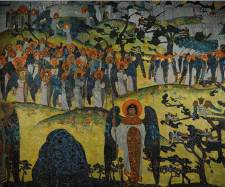

Sotheby’s appropiately describes the piece as a “tour de force in limestone”
THE GUENNOL LIONESS – SOTHEBY’S TO SELL ONE OF THE LAST KNOWN MASTERWORKS OF ANCIENT NEAR-EASTERN ART NOW IN PRIVATE HANDS
POWERFUL 5,000 YEAR-OLD FIGURE FROM THE DAWN OF CIVILIZATION IS ESTIMATED TO SELL FOR $14/18 MILLION
]]>
New York, NY, September 14, 2007 – On December 5, 2007, Sotheby’s New York will have the privilege of offering for sale one of the last known masterworks from the dawn of civilization remaining in private hands – The Guennol Lioness. Exhibiting strength, and with an expression of focused determination, this powerful and finely carved figure of a lioness was created approximately 5,000 years ago in the region of ancient Mesopotamia. Its creation was contemporaneous with the first known use of the wheel, the development of writing, and the emergence of the first cities. About 3 ¼ inches in height, the white limestone sculpture was acquired in 1948 by Alastair Bradley Martin and his wife Edith, whose revered Guennol Collection of choice masterworks across countless periods and cultures has been celebrated by scholars and museums for decades. The Guennol Lioness has been on view at the Brooklyn Museum of Art for nearly 60 years and extensively published. Diminutive in size, but monumental in conception, this icon of Near- Eastern Ancient art is estimated to sell for $14/18 million. The proceeds of the auction are to benefit a charitable trust.
Richard Keresey, Worldwide Head of Sotheby’s Antiquities Department, said, “This storied figure, in its brilliant combination of an animal form and human pose, has captured the imagination of academics and the public since it was acquired by the Martins in the late 1940s. The successful bidder in the December auction will have the distinction of owning one of the oldest, rarest and most beautiful works of art from the ancient world.”
The Guennol Lioness is a tour de force in limestone that was probably a symbol of power and owned by a figure of great importance. The commanding figure stands with her head turned over her left shoulder; paws forcibly clenched in front of her muscular chest. Despite her relatively small size, she conveys an unmistakable impression of monumentality. Noted scholar Dr. Edith Porada has described the Guennol Lioness as “a unique and remarkable example of Ancient Near Eastern sculpture.” Referring to its presence, she commented, “Perhaps the most striking feature of this sculpture is the impression of monumental power which it conveys. When seen in the original, the figure seems to fill the entire field of mental vision; even in photographs it gives the illusion of considerable size.”1 Although scholars have had access to this object for nearly 60 years, its identity, role within the system of beliefs, mythology, and the rituals of the culture that produced it, will probably remain a matter of speculation. However, the fierce aspect of the beast and the power it emanates could provide clues to the nature of the object, which perhaps was meant to repel misfortune and keep malevolent forces at bay.
The Guennol Lioness was created 50 centuries ago, in the region of the world that gave birth to writing, currency and urban centers. Based on a strong connection to a series of seal impressions featuring a striding upright leonine beast with paws locked in front of the chest, the Guennol Lioness is thought to originate in Elam, part of the cultural region of Mesopotamia. The figure is reported to have been found at a site near Baghdad, according to Joseph Brummer, the renowned New York dealer who acquired the figure in 1931 and subsequently sold it to Alastair and Edith Martin.
Follow us on:


